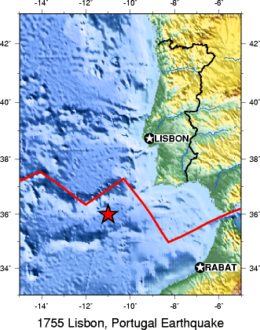The 1755 Lisbon earthquake, also known as the Great Lisbon earthquake, occurred in the Kingdom of Portugal on the morning of Saturday, 1 November, the holy day of All Saints' Day, at around 09:40 local time.[2] In combination with subsequent fires and a tsunami, the earthquake almost totally destroyed Lisbon and adjoining areas. Seismologists today estimate the Lisbon earthquake had a magnitude in the range 8.5–9.0[3][4] on the moment magnitude scale, with its epicentre in the Atlantic Ocean about 200 km (120 mi) west-southwest of Cape St. Vincent. Estimates place the death toll in Lisbon alone between 10,000 and 100,000 people,[5] making it one of the deadliest earthquakes in history.
The earthquake accentuated political tensions in the Kingdom of Portugal and profoundly disrupted the country's colonial ambitions. The event was widely discussed and dwelt upon by European Enlightenmentphilosophers, and inspired major developments in theodicy. As the first earthquake studied scientifically for its effects over a large area, it led to the birth of modern seismology and earthquake engineering.


No comments:
Post a Comment
Note: Only a member of this blog may post a comment.